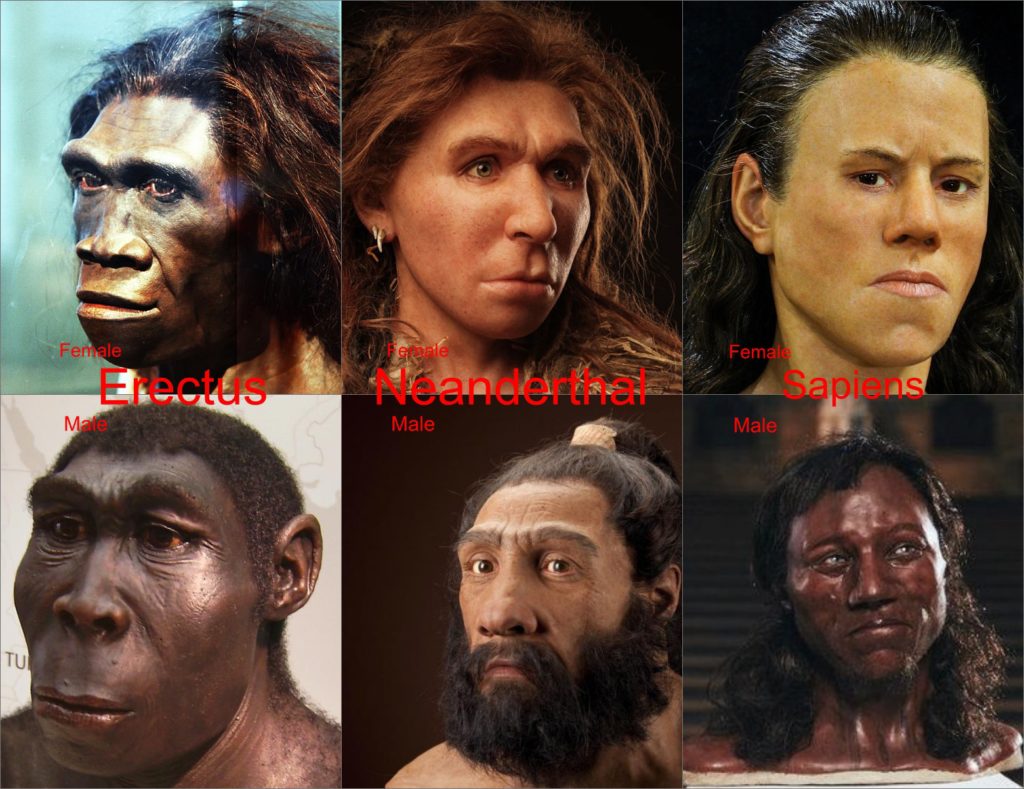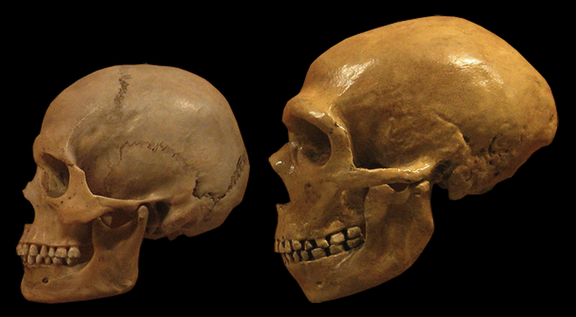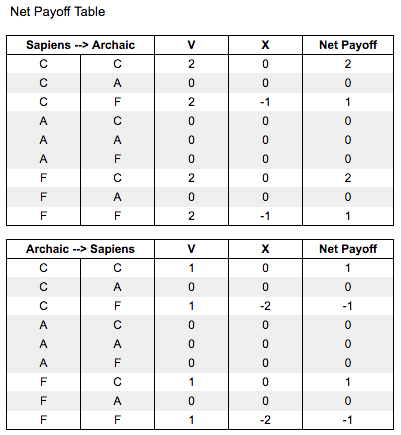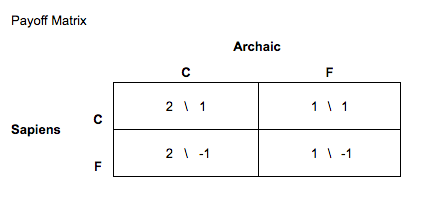This article describes a mathematical model in the form of an evolutionary game [1] that may help explain how Homo Sapiens prevailed in the struggle for survival against other archaic forms of homo, e.g. Erectus, Heidelbergensis, Antecessor, Neanderthal, Denisovan, etc., as they met when spreading across overlapping regions in Africa, Europe and Asia.
If the hypothesis is reaffirmed by further research and testing, it may be an indication that a combination of sexual success and more effective fighting tools, aided by a strong bias toward cooperation between the species, were the main culprits for determining Homo Sapiens, or its current version, as the long term ‘victor’ in these natural selection ‘contests’.

I wrote above ‘or its current version’ because if Homo Sapiens was a distinct species at some point in the past, today anatomically modern humans may likely be a synthesis or admixture between that species and the other extinct Archaic humans [2].
1. Game Contestants
The model is an evolutionary game where there are two contestants: ‘Sapiens’ representing the new immigrating version of homo, and ‘Archaic’ representing all other established regional species of homo which may have become extinct through a combination of sexual selection and violence. The model, therefore, is a description of how the interactions between species played out as they met in the corresponding geographies and timeframes according to current knowledge e.g. Sapiens vs Neanderthal or Antecessor in Europe, Sapiens vs Erectus or Heidelbergensis in Africa, and Sapiens vs Denisovans or Neanderthals in Asia.
2. Game Strategies
In this model, both Sapiens and Archaic had three possible strategies when meeting each other.
Cooperate (C)
When the two species of homo met they assessed the benefits and minimized costs of cooperation and decided to establish a non-violent interaction at least in that instance, i.e. during that iteration. This meant they avoided fighting, perhaps exchanged some material items, and may have spent some time together trying to understand their languages and cultures. The end result of this cooperation was a payoff in mating and perhaps extending their respective tribal gene pools, albeit not in the same proportions for both sides as will be seen in the assumptions below.
Avoid (A)
The other possibility, probably more common at the beginning of interactions and less common as Sapiens populations grew, is that the two species decided to avoid each other perhaps to minimize the costs of fighting and any other possible risks such as deceases or competing for resources, e.g. food, shelter, and mating partners, or just tribal apprehension. They may also have assessed, for the time being, that resources were not that scarce therefore not worth spending time and energy fighting for, but rather continue roaming in different directions. These interactions resulted in no evolutionary advantage in the form of extending gene pools other than conserving time and energy.
Fight (F)
Probably more prevalent as Sapiens populations grew, nasty fights for resources may have sometimes, depending on the circumstances, been the best rational choice for both contestants or one of the sides. Even if it seems counter-intuitive, these scenarios may have been a matter of life or death e.g. lack of food or females for mating, thus trouble extending the tribe’s genetic line. Fighting meant inflicting a considerable cost in life and resources to the other contestant, albeit not in the same proportions as we will see in the assumptions below. On the other hand, winning a fight also resulted in an evolutionary payoff in the form of reproductive success and extension of the tribal gene pool in the same proportions as the strategy of Cooperation (C) above.
3. Assumptions
Obviously the interactions between different lines of homo must have been more complex, so this model is a simplified version using the three strategic options explained in the previous section. However, the three strategies combined with the assumptions bellow could be an adequate generalization, subject to more research, discoveries and testing, to reasonably resemble the kinds of results that interactions between Sapiens and Archaic may have had.
The Advantage of Neoteny [3]
One of the main characteristics of Sapiens as compared with Archaic is higher levels of neoteny. Neoteny is the delaying of body development that may have benefited brain capacity and expression, but also may have helped in relative sexual selection success. As males and females of Sapiens looked more youthful, even as developed adults, it is my opinion that this gave them an advantage when interacting with other sub-species as well. This means that in periods of cooperation, both males and females of Archaic homo actually preferred, up to a certain extent, to mate with females and males of Sapiens rather than only with their own species.

This advantage, which I call ‘forward sexual assimilation bias’, in evolutionary reproductive success, label ‘V’ in the model, may have been very significant, but for the purposes of this model I will give it a ratio of 2 to 1 in favor of Sapiens when mixing with Archaic. The sexual selection bias was of course present in Sapiens with Sapiens as well, meaning that Sapiens males and females also preferred mainly to mate with other Sapiens rather than with Archaic, but this did not preclude them completely from mating with Archaic. It is entirely possible that isolated roving bands of Sapiens may have had low female counts, e.g. due to maternal mortality rates at birth, so they needed to mix with Archaic from time to time to preserve their family lines. The same would happen if the bands had less males, e.g. due to fighting deaths or hunting accidents, and needed more genetic diversity.

This neotenous sexual advantage is assumed to also have an influence after fighting interactions, not only during cooperation. This means that when Sapiens won fights they would mate with Sapiens and Archaic in a 2 to 1 ratio, and when Archaic won the fights, they would also sexually select Sapiens over Archaic mates in a 2 to 1 ratio.

The Advantage of Flying Spears, Throwing Ability, and Bow and Arrows [4][5]
When analyzing hunting and stone tools from Neanderthals specifically, they have several features that show that they were not very practical as projectiles, in the case of spears, and that Homo Neanderthalis didn’t have the technology of bow an arrows that Sapiens brought when they started to encounter each other in Europe. Another difference is that Sapiens were anatomically better built to throw spears, and maybe other kinds of weapons, longer distances because of the possibility of backward displacement at the throwing shoulder joint, a feature that Neanderthal fossils don’t show.

These differences in projectiles, tools, and throwing abilities were likely present between Sapiens and their potential opponents when encountering Archaic humans in other regions. They basically enabled Sapiens, when engaging in fights with Archaic humans, to be able to keep a distance and not to be as exposed to injury and death as the others, even if Sapiens had relatively more childish bodies, thinner muscles, and weaker bones.

For the above reasons, Sapiens must have been more effective when the ‘game choice’ was to fight, so for the purposes of this model I am going to give an advantage of -1 to -2 to Sapiens. This means that when Archaic inflicted an evolutionary cost, labeled ‘X’ in the model, to Sapiens when fighting, that value will be -1, and when Sapiens inflicted it to Archaic, it will be -2.
4. Net Payoff Table and Game Payoff Matrix
The strategies described in point 2 above (C, A and F) are combined in the table below, organized by contestant (Sapiens or Archaic), and assigned a payoff ‘V’ and a cost ‘X’ to calculate a ‘net payoff’ per strategy combination.
The interactions are contests only between Sapiens and Archaic, so they don’t include iterations where tribes, bands, or clans of the same species interacted between themselves.
As there are 3 possible strategies by 2 contestants, there are a total of 18 possible combinations, however, all of the iterations that contain an A on any side result in zero values for both sides because the interaction was avoided. Therefore, I am going to describe, after the table, only the interactions that generate any non-zero results. Also, because the assumptions determine two asymmetries, where Archaic gets lower scores in reproductive success and in fighting success, I am going to describe the interactions grouped under Sapiens (4) and under Archaic (4) because they all have different results. When the notation is written as for example ‘Sapiens CF’, it means that Sapiens made the move cooperating and Archaic responded by fighting. If the notation is ‘Archaic FF’, it means that Archaic made the move fighting and Sapiens responded by fighting.
According to the assumptions in section 3 above, the only possible values in the case of reproductive success are 1 for Archaic or 2 for Sapiens, and the only possible values in case of fighting losses are -2 for Archaic and -1 for Sapiens. As said above, all interactions where one of the parties avoids the interaction have 0 values for both contestants.
Table

Cost = X
Net Payoff = Net between V and X
All results that include an Avoid (A) strategy pairing are = zero because there is no payoff nor cost inflicted.
Explanation of Interactions Excluding the Ones that Have ‘A’ Strategies
Sapiens CC: Sapiens decides to cooperate with Archaic, and Archaic responds by cooperating. Therefore, Sapiens has a sexual success of 2, and is inflicted a cost of 0.
Sapiens CF: Sapiens decides to cooperate with Archaic, but Archaic responds by fighting. Therefore, Sapiens has a sexual success of 2, but is inflicted a cost of -1.
Sapiens FC: Sapiens decides to fight with Archaic, but Archaic responds by cooperating (not fighting or was caught by surprise). Therefore, Sapiens has a sexual success of 2, and is inflicted a cost of 0.
Sapiens FF: Sapiens decides to fight with Archaic, and Archaic responds by fighting back. Therefore, Sapiens still has a sexual success of 2, but is inflicted a cost of -1 by a more aggressive Archaic.
Archaic CC: Archaic decides to cooperate with Sapiens, and Sapiens responds by cooperating. Therefore, Archaic has a sexual success of 1, and is inflicted a cost of 0.
Archaic CF: Archaic decides to cooperate with Sapiens, but Sapiens responds by fighting. Therefore, Archaic has a sexual success of 1, but is inflicted a cost of -2.
Archaic FC: Archaic decides to fight with Sapiens, but Sapiens responds by cooperating (not fighting or was caught by surprise). Therefore, Archaic has a sexual success of 1, and is inflicted a cost of 0.
Archaic FF: Archaic decides to fight with Sapiens, and Archaic responds by fighting back. Therefore, Archaic still has a sexual success of 1, but is inflicted a cost of -2 by a more aggressive Sapiens.
Evolutionary Game Theory Payoff Matrix
A Strong Bias Toward Cooperation
Below are the eight net payoffs described above laid out in the traditional evolutionary game theory payoff matrix:

In this matrix Sapiens and Archaic fare relatively better by fighting when the other cooperates, these are their respective FC matches. However, if they would consistently follow those strategies, they would also both consistently retaliate, therefore moving the game to FF which is worse for both sides. This state of affairs would probably provide incentives for both to cooperate. On the other hand, constant cooperation would be an incentive for any side to cheat from time to time by fighting and reaping the temporary rewards, albeit not consistently. These dynamics indicate, that their strategies must have been mixed, alternating between C, A and F, but with a strong bias towards cooperation.
Delving in more detail in the payoff matrix, the only strategies where Archaic gets positive net rewards in the form of reproduction success are Archaic CC or FC, the latter where there is a sort of ‘surprise’ attack on Sapiens or where Sapiens just collaborates (gives up) because it was not prepared to fight back. However, in the long run Archaic would probably try to minimize the use of that strategy because future retaliations by Sapiens would more than offset its meager gains. Similarly, in the long run Sapiens would try to avoid Sapiens FC because Archaic would increase their preparedness and retaliation and steer the game more towards FF, which is less evolutionarily profitable for both sides.
Does the above evolutionary game mean that Sapiens and Archaic spent more time cooperating than fighting? Although Sapiens had a fighting asymmetry to their advantage, because that asymmetry was not overwhelming, and they were reproductively compatible, it is very plausible that the answer to this question is yes. In the next section two simulations are presented.
5. Contest Simulations and Iteration Results
Below I constructed two hypothetical 30 year contests played between Sapiens and Archaic annually. This means that they encountered each other and interacted, choosing any of the three strategies, once a year for 30 years.
The First Contest – Manual
The first contest simulation below is manually organized in 3 epochs where I imagined that when Sapiens and Archaic met for the first time, and for the first 10 years, the first epoch, they essentially avoided each other. This may have been for any number of reasons, but mainly for security, to avoid unnecessary costs, and perhaps because the region was still large and open for foraging. This first epoch yielded 0 benefits or costs for both contestants. In the second epoch I made them essentially fight the majority of the time, with one iteration where they cooperated and a couple more where at least one tried to cooperate, but the other fought back. This is because I imagined that after several years of avoidance, they finally had to confront each other due to a growing Sapiens presence and larger population in the region, and resources may have been depleting. This period yielded 12 points to Sapiens and a catastrophic -6 points to Archaic. In the third and final epoch of this simulation I imagined a situation where they learned more about each other, especially how fierce both sides could be, even with Archaic’s disadvantages, and that perhaps it was a better option to try to cooperate as much as possible. However, like humans that we are (and were), there is one instance of a full bilateral fight and two instances where one side fought while the other cooperated (or tried to). This epoch yielded 18 points to Sapiens and 6 points to Archaic.

Although, the epochs above are very rationalized and balanced by me, I think both Sapiens and Archaic were intellectually advanced enough during the middle and upper paleolithic to have that kind of strategic thinking and planning qualities. What I think is very telling is that the first epoch basically didn’t produce any advantages for any of the species, but the second, more bellicose epoch clearly was a bad period for Archaic. Interesting as well is that in the third epoch Archaic could at least recover what was lost during the warring years by trying to stay in a cooperative mode. However, as it can be seen by the 30 to 0 result above, even with the applied strategic thinking and design of the game, Archaic did not have much, or could not have much success due to it’s structural sexual and fighting tool disadvantages.
The Second Contest – Random
In this second contest all choices by Sapiens and Archaic where randomly selected using the dice system at RANDOM.ORG. I selected to roll the dice 60 times and when the result was 1 or 2 I wrote C, 3 or 4 I wrote A, and 5 or 6 I wrote down F for the players starting with Sapiens’s first move and ending with Archaic’s last move. The results are below.

The results in the random contest yielded 20 points for Sapiens and 4 points for Archaic. Evidently the comparative advantages that Sapiens had when encountering other humans were very powerful and permitted the species to advance it’s genetic pool and significantly diminish all Archaic as it advanced in its multi-territorial conquest. The way nature distributed the different Archaic humans in the different regions, however perfectly adapted for their local environments, didn’t prepare them to ‘defend’ their respective genetic lines very much other than by mixing with the newcomers as much as possible to perpetuate some of their genes. A phenomenon which can actually be observed today in anatomically modern humans [6].
In terms of how things were from their perspective, or how they could best optimize their situation given their disadvantages, all this left Archaic with only a few, or a combination of a few, strategies: To always avoid confrontation, to always collaborate, or a combination of both. To always avoid confrontation would have created a situation similar to the last Neanderthals who’s remains where found in 1848 in Gibraltar [7], who were pushed or escaped to the edges of the continent and somehow perished 25,000 thousand years ago. Or, perhaps they were assimilated, which was the destiny they were apparently trying to avoid all along. To always collaborate was not possible because it would have opened a flank for Sapiens who would certainly fight from time to time when Archaic was not ready, distracted, or was willing to collaborate (not fight) as a defense of last resort. So, the best option seemed to have been a mixed strategy of avoiding and collaborating, but in both cases the results did not generate high reproductive yields as seen in the simulations above.
6. Conclusion
The experiment above doesn’t provide much information as to real quantities such as population estimates, timespans, probabilities, and Sapiens vs Archaic interaction frequencies. For example, except for the last remnants in Gibraltar, it probably took Neanderthals between 2,600 and 5,400 years for their presence to significantly diminish in Europe after Homo Sapiens arrived [8]. However, I think that if the strategy options and assumptions are roughly right, meaning that Sapiens and Archaic had the options to avoid each other, fight each other, or collaborate with each other, and that Sapiens had the two key advantages of sexual attractiveness through neoteny and fighting advantages through its weaponry and projectiles, then this model may be quite plausible.
Everything in this article is fairly testable and refutable with alternative models and existing or further research and discoveries.
The most important points of the hypothesis laid out in this article are:
1. Although Sapiens had a fighting advantage, that advantage was not overwhelming.
2. The above means Archaic could inflict considerable evolutionary costs by fighting back.
3. Sapiens and Archaic were reproductively compatible.
4. The fact they were reproductively compatible means there was an evolutionary payoff for both species by collaborating while minimizing fighting costs.
5. There was a sexual asymmetry in that Archaic versions had a preference, i.e. forward sexual assimilation bias, to mate with Sapiens.
6. Even after fighting, whoever lost in that type of interaction still had mating payoffs, albeit in proportions that benefited Sapiens.
Whether there is an evolutionarily stable strategy in the games described in this article is difficult to assess by me, but if any mathematician, computer programmer, paleoanthropologist, archeologist, or evolutionary biologist would like to run the scenarios and do the calculations I would be glad to collaborate.
In conclusion, the results of the model in this article are that the structural sexual and fighting disadvantages that Archaic humans had, when they encountered Sapiens anywhere in the world, diminished the permanence of their species no matter what strategy they used or combination thereof. This is what is objectively observed in reality today. Therefore, through a combination of fighting, avoidance and cooperation, with a strong bias toward the latter, and aided by a forward sexual assimilation bias, the current version of homo, known as anatomically modern humans, is very likely a synthesis of the several Archaic humans that we don’t see anymore today. This means they were overcome by the superior fighting tools and the relative sexual success of one of their Archaic, albeit more evolved, peers: Homo Sapiens.
References
[1] Evolutionary Game Theory Explained: The Logic of Animal Conflict by J. Maynard Smith and G. R. Price: http://etherplan.com/the-logic-of-animal-conflict.pdf
[2] The American Society of Human Genetics (ASHG): Ancient Human History More Complex than Previously Thought by Ryan J. Bohlender, PhD: http://www.ashg.org/press/201610-admixture.html
[3] Neoteny in Humans by Wikipedia: https://en.wikipedia.org/wiki/Neoteny_in_humans
[4] Neanderthal vs Cro-Magnon Man Spears by John Shea, State University of New York: https://youtu.be/yWZwWcQAtKI
[5] Neanderthals lacked projectile weapons by Jennifer Viegas, Discover News: http://www.nbcnews.com/id/28663444/ns/technology_and_science-science/t/neanderthals-lacked-projectile-weapons/#.Ww3xaFMvzBI
[6] Ancient humans were mixing it up: Anatomically modern humans interbred with more archaic hominin forms while in Africa by M. F. Hammer, University of Arizona: https://www.sciencedaily.com/releases/2011/09/110905160918.htm
[7] The Rock of Gibraltar: Neanderthals’ Last Refuge by Erin Wayman, Simthsonian.com: https://www.smithsonianmag.com/science-nature/the-rock-of-gibraltar-neanderthals-last-refuge-42545293/
[8] Humans Did Not Wipe Out the Neanderthals, New Research Suggests by Charles Q. Choi, LiveScience: https://www.livescience.com/47460-neanderthal-extinction-revealed.html